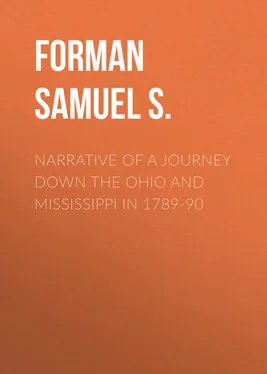In Westmoreland county we had a little trouble with a drunken justice of the peace and some free blacks. These free blacks, as we learned from a faithful old colored woman, furnished the two ill-tempered blacks of our party with old swords and pistols, but nothing serious grew out of it.
The weather began to grow very cold, the roads bad, and traveling tedious. We encamped one night in the woods, kindled a fire, and turned the tails of the wagons all inward, thus forming a circle around the fire. Another night we came to a vacant cabin without a floor; we made a large fire, and all who chose took their bedding and slept in the cabin, some remaining in the wagons. The captain and I had our beds spread before the fire.
Конец ознакомительного фрагмента.
Текст предоставлен ООО «ЛитРес».
Прочитайте эту книгу целиком, купив полную легальную версию на ЛитРес.
Безопасно оплатить книгу можно банковской картой Visa, MasterCard, Maestro, со счета мобильного телефона, с платежного терминала, в салоне МТС или Связной, через PayPal, WebMoney, Яндекс.Деньги, QIWI Кошелек, бонусными картами или другим удобным Вам способом.
This incident, occurring in May, 1780, is related in Barber and Howe’s New Jersey Historical Collection , 345-6.
Major John Burrows was first a captain in Colonel David Forman’s regiment. Forman had the nick-name of “Black David,” to distinguish him from a relative of the same name, and he was always a terror to the Tories; and Captain Burrows, from his efficiency against these marauders, was called by those enemies of the country, “Black David’s Devil.” January 1, 1777, Captain Burrows was made a captain in Spencer’s regiment on Continental establishment; and, January 22, 1779, he was promoted to the rank of major, serving in Sullivan’s campaign against the hostile Six Nations, and remaining in the army till the close of the war. Several years after, he went on a journey to the interior of Georgia, in an unhealthy season, when he probably sickened and died, for he was never heard of afterward.
Major Burrows left an interesting journal of Sullivan’s campaign, which appears in the splendid volume on that campaign issued by the State of New York, in 1887. The original MS. journal is preserved by his grand-daughter, Mrs. Elizabeth Breese Stevens, of Sconondoa, Oneida county, New York.
This is an error. Bayonet charges were resorted to by Morgan at the Cowpens, and in other engagements.
This was John N. Cumming, who rose from a lieutenant to be lieutenant-colonel, commanding the Third New Jersey Regiment, serving the entire war.
The editor, while at Saratoga Springs, in 1838, took occasion to visit the venerable Anthony Glean, who resided in the town of Saratoga, and who was reputed to be the person who climbed the greased flag-staff at the evacuation of New York, and who himself claimed to have performed that feat. He was then a well-to-do farmer, enjoying a pension for his revolutionary services, and lived two or three years later, till he had reached the age of well-nigh ninety. The newspapers of that period often referred to him as the hero of the flag-staff exploit, and no one called it in question.
General Forman was born near Englishtown, Monmouth Co., New Jersey. He was, during the Revolutionary war, a terror to the tories of his region, and as brigadier-general commanded the Jersey troops at the battle of Germantown. No less than eighteen of the Forman connection were in his brigade in this engagement. He was subsequently a county judge, and member of the council of state. He died about 1812.












